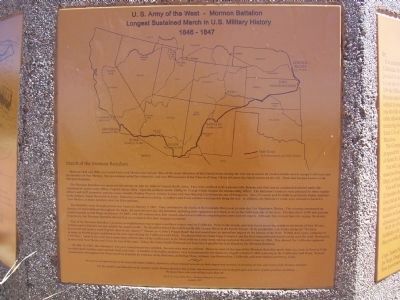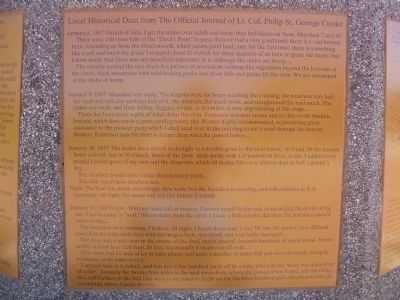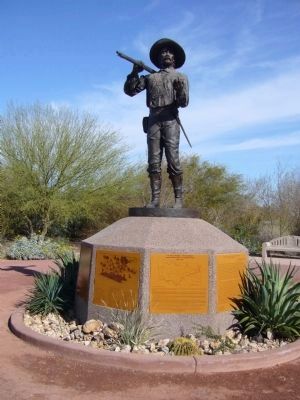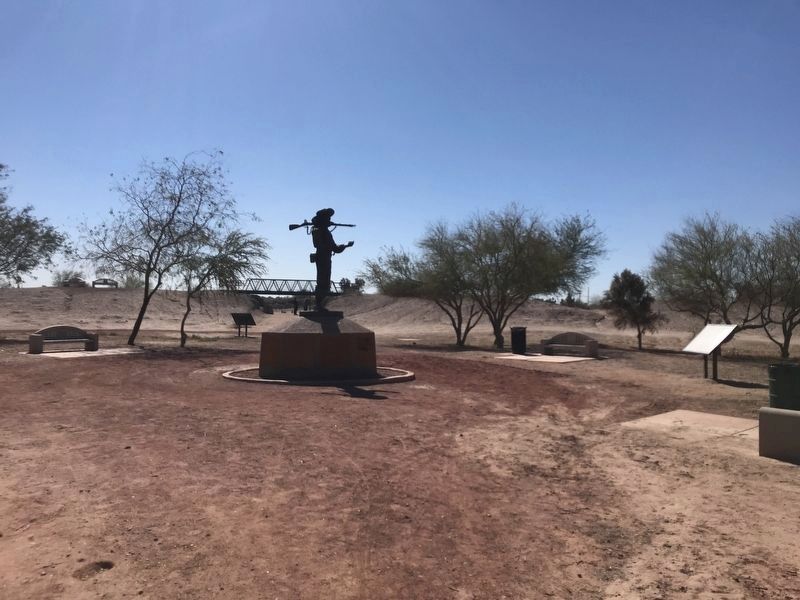Yuma in Yuma County, Arizona — The American Mountains (Southwest)
U.S. Army of the West — Mormon Battalion
Longest Sustained March in U.S. Military History, 1846-1847
Between 1846 and 1848, the United States and Mexico went to war. One of the major directives of the United States during this war was to secure its western border and to occupy California and the territory of New Mexico. The government asked for volunteers, and over 500 members of the Church of Jesus Christ of Latter-day Saints answered the call. Their unit became known as the Mormon Battalion.
The Mormon Battalion was mustered into service on July 16, 1846, in Council Bluffs, Iowa. They were outfitted at Ft. Leavenworth, Kansas, and their march continued westward under the command of regular army officer, Captain James Allen. Upon his untimely death, Phillip St. George Cooke became the commanding officer. The Battalion's numbers were enlarged by other regular officers and staff, teamsters, and ten scouts, notably, Pauline Weaver, Antoine Leroux, and Jean Baptiste Charbonneau, son of Sacagawea. Also, 33 women and 51 children, primarily family members of the soldiers, began the march in Iowa. Enduring tremendous hardship, 22 soldiers and 8 non-soldiers would perish along the way. In addition, the Battalion's ranks were reduced at Santa Fe, New Mexico, as many members were too ill to continue.
The Battalion came through present-day Yuma on January 9, 1847. They continued to the banks of the Colorado River, near present-day Los Algodones, Mexico. The crossing commenced on January 10 and continued throughout the night. By noon the next day, the Battalion, including their equipment and stock, were on the California side of the river. The Battalion's 2,000 mile journey would conclude in San Diego on January 29, 1847, with 335 enlisted men, four women, and several children completing the entire historic march. Although they were prepared to engage the enemy if necessary, the Mormon Battalion did not find an occasion to fire their weapons in combat.
One of the Mormon Battalion's greatest accomplishments was to open a southern wagon route to California. Prior to the march, east-west travel across the southern territories of New Mexico, Arizona, and California was not suitable for wagon traffic. The Battalion blazed the trail from the Rio Grande River to the Pacific Ocean. At its conclusion, Col. Cooke declared, "We have discovered and made a road of great value to our country." Known as "Cooke's Wagon Road" the trail would have an immediate impact on the history of the West. Within three years, estimates of as many as 60,000 people would travel the new route during the California Gold Rush. The Butterfield Overland Stage Company and the first transcontinental mail service used the trail. During the Civil War, control of the road was a main focus of both sides of the conflict here in the West, with the Union Army taking control of the entire route by 1864. This allowed the California regiments to move into New Mexico and Texas by way of the road. Today, the Union Pacific Railroad and Interstate 8 parallel the trail blazed by the Mormon Battalion.
On July 16, 1847, the volunteers’ one-year commitment was satisfied. Seventy-nine men re-enlisted. However, most of the men of the Mormon Battalion made their way back to Iowa or Utah to rejoin their families and conclude their trek west. A handful of Battalion members were instrumental in the discovery of gold at Sutter's Mill, ushering in the California Gold Rush. Several communities throughout the West would be founded by veterans of the Battalion, including Mesa, Arizona, San Bernardino, California, and both Ogden and Provo, Utah.
We express our appreciation to the many individuals, families, businesses and government agencies for their support and resources in honoring the men and women of the Mormon Battalion. It is the sacrifice and dedication of the members of the Mormon Battalion that so fully demonstrated their resolve to the principles and values of faith, freedom, and liberty. We honor those who were willing to give their all.
Erected 2007 by The U.S. Army of the West - Mormon Battalion Foundation.
Topics and series. This historical marker is listed in these topic lists: Exploration • War, Mexican-American • War, US Civil. In addition, it is included in the Mormon Battalion series list. A significant historical month for this entry is January 1898.
Location. 32° 43.867′ N, 114° 38.739′ W. Marker is in Yuma, Arizona, in Yuma County. Marker can be reached from 12th Avenue, ¾ mile west of Water Street. Touch for map. Marker is in this post office area: Yuma AZ 85369, United States of America. Touch for directions.
Other nearby markers. At least 8 other markers are within 2 miles of this marker, measured as the crow flies. Immaculate Conception Parish (approx. one mile away); Yuma Crossing (approx. 1.3 miles away); Yuma Crossing Park (approx. 1.3 miles away); Southern Pacific Passenger Coach Car (approx. 1.3 miles away); Robert G. Fowler (approx. 1.3 miles away); a different marker also named Robert G. Fowler (approx. 1.3 miles away); Office of the U. S. Army Depot Quartermaster (approx. 1.4 miles away); Quartermaster Depot Water Reservoir (approx. 1.4 miles away). Touch for a list and map of all markers in Yuma.
More about this marker. This large statue and historical marker is located in the West Wetlands Park near the banks of the Colorado River in Yuma, Arizona. From Interstate 8 in California at the Arizona border, take Exit 172 (Winterhaven/Fourth Ave), then go south on 4th Avenue for .4 miles, across the Colorado River into Arizona. Turn right on 1st Street and go west for .58 mile to 12th Avenue. Go north on 12th Avenue for .25 mile, past Colorado Street and Water Street, into West Wetlands Park. From the entrance, drive about ¾ of a mile further into the park, to the west end...find parking lot and follow the trail marked by signs.
Regarding U.S. Army of the West — Mormon Battalion. Statue is almost double life-sized, with 8 information plaques around the base.
Related markers. Click here for a list of markers that are related to this marker. To better understand the relationship, study each marker in the order shown.
Also see . . . U.S. Army of the West - Mormon Battalion Foundation. (Submitted on September 20, 2009.)
Credits. This page was last revised on November 1, 2022. It was originally submitted on September 20, 2009. This page has been viewed 3,960 times since then and 65 times this year. Last updated on September 23, 2009. Photos: 1, 2. submitted on September 20, 2009. 3. submitted on March 22, 2010, by Bill Kirchner of Tucson, Arizona. 4. submitted on February 8, 2022, by Adam Margolis of Mission Viejo, California. • J. J. Prats was the editor who published this page.



